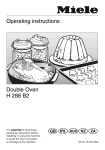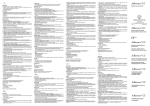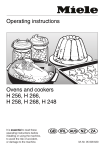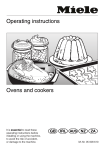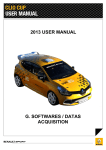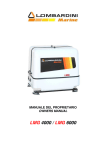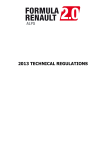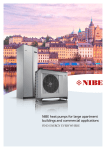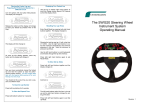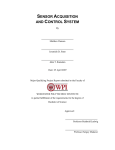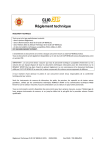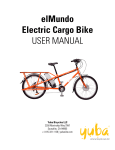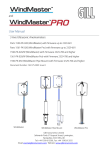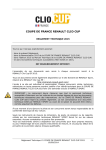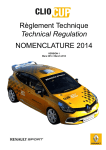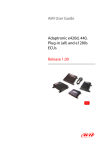Download C - Engine - V-line organización
Transcript
2013 USER MANUAL C. ENGINE 98CUP_2013 Release C ENGINE CONTENTS C ENGINE 2 C.1 ENGINE 4 C.1.1 IDENTIFICATION 4 C.1.2 TRANSPORT 4 C.1.3 CHARACTERISTICS 5 C.1.4 LUBRICATION 5 C.1.5 SEALED PARTS 6 C.1.6 REMOVAL OF THE POWERTRAIN 9 C.1.7 REFITTING OF THE POWERTRAIN 13 C.1.8 CONNECTING TORQUE ROD YOKE 14 C.1.9 ENGINE MOUNTINGS 15 C.1.10 GEARBOX MOUNTINGS 16 C.1.11 EXHAUST LINE / TURBO HEAT SHILEDS 17 C.1.12 WATER CIRCUIT BUCKLE ON WATER BOX 19 C.2 POWERTRAIN MANAGEMENT 20 C.2.1 OPERATING PRINCIPLE 20 C.2.2 STARTING 21 C.2.3 DECELERATION CUT-OFF 21 C.2.4 SHIFTING STRATEGIES 22 C.2.5 BATTERY VOLTAGE 22 C.2.6 ENGINE / GEARBOX MAP 22 C.2.7 COOLING FANS 22 C.2.8 COLD START 22 C.2.9 OPERATION IN DOWNGRADED MODE 23 C.2.10 ENGINE PROTECTION 23 C.2.11 ELECTRONICS AND ELECTRIC DEVICES 24 C.2.11.1 ELECTRONICS CONTROL UNIT : COSWORTH SQ7DIRST 01E-501070-RST 24 C.2.11.2 DASHBOARD : COSWORTH ICD 01D-032954-RST 24 C.2.11.3 ELECTRONIC FUSE BOX : XAP_CBNT98 24 C.2.11.4 STEERING WHEEL SWITCH PANEL : XAP_STER98 25 C.2.11.5 FACIA SWITCH PANEL : XAP_SWT98 25 C.2.11.6 MASTER RELAY : XAP_RELAY 25 C.2.11.7 GEARBOX SHIFTING ACTUATOR: XAP_ESHIFT98 25 C.2.12 AIR INTAKE / EXHAUST 26 C.2.12.1 PRINCIPLE 26 C.2.12.2 AIR SENSORS AND ACTUATORS 26 C.2.13 FLY BY WIRE 28 C.2.13.1 MOTORISED THROTTLE / THROTTLE POSITION SENSOR (TPS) 28 C-2 98CUP_2013 Release C.2.13.2 GAS PEDAL POTENTIOMETER SENSOR (PPS) C.2.13.3 GAS PEDAL / THROTTLE POTENTIOMETER LEARNING C.2.14 FUEL INJECTION C.2.14.1 PRINCIPLE C.2.14.2 ACCESS HATCH C.2.14.3 FUEL TOWER C.2.14.4 LOW PRESSURE FUEL SENSOR (3) C.2.14.5 HIGH PRESSURE (HP) PUMP ELECTRO VALVE (11) C.2.14.6 INJECTION RAIL C.2.14.7 HIGH PRESSURE FUEL SENSOR (13) C.2.15 IGNITION C.2.16 VARIABLE VALVE TIMING (VVT) C.2.16.1 INTAKE CAMSHAFT SOLENOID VALVE C.2.16.2 INTAKE CAMSHAFT PHASE SENSOR C.2.17 OTHER ENGINE SENSORS C.2.17.1 WATER TEMPERATURE SENSOR C.2.17.2 OIL PRESSURE SENSOR C.2.17.3 CRANKSHAFT PHASE SENSOR (TDC OR S MOT) C-3 29 29 31 31 31 31 31 32 32 32 33 33 33 34 34 34 35 35 98CUP_2013 Release C.1 ENGINE C.1.1 IDENTIFICATION The engine is identified by an engraving made on the engine block. It is located on the intake side, on the vertical face of the starter fitting B It includes: C Area A: the engine type and homologation : M5MA Area B: the engine index : 400 Area C: the engine manufacturing number Here “P000xxx” A reminder of the engine manufacturing number is also engraved on the head cylinder behind the engine mounting A Starter Gearbox These 2 numbers must be the same, if it’s not the case, it will be considered as a technical non conformity Any procedure carried out on the engine not included in this manual must be performed by a Renault Sport accredited engine partner. C.1.2 TRANSPORT To facilitate the engine transportation, a specific kit has been developed. This kit is available from Renault Sport spare parts department under the following reference: 8201 400 360 NOTE : This kit is mandatory in case of engine shipment to ORECA Magny Cours or to RENAULT SPORT C-4 98CUP_2013 Release C.1.3 CHARACTERISTICS Type: M5MA 400 Number of cylinders: 4 in-line Number of valves: 16 Capacity: 1618 cm3 o Bore : 79.7mm o Stroke : 81.1mm Injection type : direct injection (HP fuel pump) Turbo charged ( waste gate and pop-off electro valve) Max. power: 162 kW (220bhp) at 6,000rpm Max. torque: 280Nm at 4.750rpm (average 270N.m between 2500 and 6000rpm) Max. engine speed: 6,500rpm C.1.4 LUBRICATION To prevent any oil surge, it is essential to drive with a minimum of 4.5 Liters First oil change Oil change rate Lubricant After 500km Every 1,000km Elf Excellium NF 5W40 MANDATORY The recommended oil level is the maximum position on the dipstick (H) which corresponds to 4.2L (oil filter included) C-5 98CUP_2013 Release OIL LEVEL position (oil filter filled) 1 2 3 4 LOW Level 5 6 Level 0 : Low level 1 2 3 4 5 6 : high level Position (mm) 0 7 15.7 21.8 27.5 32.5 38 = HIGH Level = recommanded level Oil quantity (L) 2.5 2.8 3.2 3.5 3.8 4.0 4.2 C.1.5 SEALED PARTS The engine has sealed parts. The presence of these sealed parts is mandatory. No procedure may be carried out on the engine without a representatives of Renault Sport (Scrutinneers, technical responsible and official engine Tuner ORECA MAGNY COURS) TOTAL = 9 Seals - Timing cover 2 drilled screws 1 plastic seal Exhaust camshaft actuator (Not plugged!!) - Turbo upstream pipe and Waste gate lung screw 1 drilled waste gate screw 1 drilled Turbo upstream pipe screw 1 steel seal View from exhaust side C-6 98CUP_2013 Release - Turbo charger clamp 1 drilled clamp 1 steel seal Turbo charger heat shield View from exhaust side - Oil sump 1 drilled screw (head and last threads) 1 plastic seal Cylinder block / lower part Oils sump View from intake side - Waste gate hoses 2 x 2 drilled clamp 2 plastic seals Waste gate EV Hose coming from the airbox Waste gate EV : 1 seal on hoses between the drilled clamps - - Waste gate lung Pop off valve 2 drilled screws 1 plastic seal Pop off valve C-7 Turbo exit hose (before Turbo air cooler) 98CUP_2013 Release - Manifold Pressure sensor (downstream of the motorised throttle) 1 drilled screw Motorised 1 plastic seal throttle body - - Air temp + boost pressure sensor 1 drilled screw 1 plastic seal ORECA Electronic TAG Fitted on a head cylinder cover scew C-8 98CUP_2013 Release C.1.6 REMOVAL OF THE POWERTRAIN Operations Pictures 1 - Disconnect the battery 2 - Remove the 2 driveshafts nuts 2 4 3 Remove the air intake circuit : 3- - 1 Air box and its support (1) Upstream hose (2) dowstream hose (3) 4 - Raise the vehicle. 5 - Remove the front bumper and headlights Remove the gearbox cooling circuit : 2 hoses 6 - to the cooler 1 Remove the upper plastic crossbeam (1) 7 - Attach the coolers to the engine, using plastic clips or straps. 2 Remove the front crossbeam (2) (gearbox 8 - cooler remains fitted) and the 3 front air ducts (3) 3 C-9 98CUP_2013 Release 1 Disconnect connectors: the following front loom - Engine cooler Fan : 2 connectors on the relay (1) 1 connector on the Fan engine (2) - Turbo air cooler 1 connector (3) - XAP Gearbox actuator (4) if fitted on gearbox (+12v supply and red connector) 9- 3 2 Bring all connectors back to the chassis NOTE : the front loom remains fitted on the chassis 4 Removing the coolers : 10- - Drain the engine water by removing the cooler lower hose and remove the cooler after disconnecting the 2 hoses (fan remains fitted on it) - Disconnect the 2 hoses and remove the turbo cooler (fan remains fitted on it) 8 5 11- Disconnect the engine loom connector situated on engine bulkhead left hand side (facing the engine) (5) Bring the connector back to the engine. Figure 1 C-10 98CUP_2013 Release Disconnect the starter/alternator power loom : - 1 nut on the breakout box (situated in driver’s compartment, on the right hand side of the ECU) (6) 7 6 - Unscrew the bulkhead connector (7) - Pull the power loom from engine side and bring the connector back to the engine (8), see figure 1 on previous page 12-To engine starter / alt To chassis loom 13- Remove the clutch slave cylinder adapter on the master cylinder +12v from XAP master relay feeding Note: Watch out for fluid discharge. Unscrew the fuel pipe union, at the ”T” on the 14- bulkhead side and fit a cap on both sides to protect the fuel hose from dirtiness 1 15- Disconnect the lambda sensor (1) and bring the corresponding chassis connector back to driver’s compartment Remove the exhaust line clamp before intermediate line (2) the C-11 2 98CUP_2013 Release Subframe Remove : 1 - The 2 anti roll bar rods (let them fitted on the damper strut) - The steering ball joint from the uprights - The lower wishbones ball joints on the uprights (let the wishbones fitted on the subframe) - The steering intermediary shaft (access in driver’s compartment behind the pedal box) (1) 16- Disconnect the connecting torque rod yoke from the gearbox by removing the screw (2) - 2 Remove the square if necessary (2 more screws) Then Remove the complete subframe (See chapter D : Front axle/Removing the subframe) Remove the 2 driveshafts: 17- - Extract the driveshaft on the gearbox side. Extract the driveshaft on the wheel side. 18- Place the powertrain on a hydraulic plate and lift it slightly using wood spacers Separate the gearbox mounting by removing the screw (1) If necessary , remove the support on the gearbox (4 screws) 1 19- C-12 98CUP_2013 Release Separate the engine mounting when removing the screw (2) 19-2 A 20- Take out the powertrain lowering the hydraulic plate. NOTE : to lift the power train, fit the adapted engine lift brackets - 1 front bracket on head cylinder near the engine mounting (A) - 1 specific rear bracket between upstream turbo pipe and engine, fitted on head cylinder Rear bracket : 8201 428 360 C.1.7 REFITTING OF THE POWERTRAIN Carry out the previous operations in reverse order. When refitting the powertrain, it is important to comply with the following positioning procedure for the powertrain in order to guarantee the operational clearances required for the driveshafts. C-13 98CUP_2013 Release C.1.8 CONNECTING TORQUE ROD YOKE gearbox subframe gearbox N° Part Ref Qty 1 Torque rod yoke 8201354335 1 2 Ball joint 7711160476 1 3 Lower spacer 8201354569 1 4 Upper spacer 8201354558 1 5 Snap ring 7711160477 1 6 Silent block 7711160043 2 7 Washer M12 7711156931 2 8 Screw M12-90 7703602201 1 9 Triangle bracket 8201368206 1 10 Screw M12-85 8201368275 1 105 N.m 11 Screw M8-20 7711128280 2 30 N.m 12 Washer M8 7711156945 2 C-14 Torque thread 105 N.m Cooper grease Cooper grease LOCT 243 (blue) 98CUP_2013 Release C.1.9 ENGINE MOUNTINGS N° Part Ref Qty Torque thread 1 Engine/engine mounting 8201355219 1 2 Engine mountings interface 7711167027 3 1 100 N.m LOCTITE 243 (blue) Screw M10-30 7711156933 7 62 N.m LOCTITE 243 (blue) 62 N.m LOCTITE 243 (blue) 105 N.m Cooper grease 4 Contact washer Ø10 7711156944 8 5 Engine/engine mounting shim 8201362862 1 6 Screw M10-90 7711127847 1 7 Engine/chassis mounting 8201354703 1 8 Silent bloc 7711160043 2 9 Washer Ø10 7703053341 3 10 Screw M12 - 98 7711167029 1 11 Washer Ø12 7711156931 1 C-15 98CUP_2013 Release C.1.10 GEARBOX MOUNTINGS CHASSIS CHASSIS GEARBOX CHASSIS GEARBOX N° Part Ref Qty 1 Gearbox/gearbox mounting 8201371034 1 2 Silent bloc 7711160043 2 3 Screw M10-20 7711128989 4 Torque thread 70 N.m LOCTITE 243 (blue) 4 Contact washer Ø10 7711156944 7 5 Gearbox/chassis mounting 8201360377 1 6 Gearbox mountings interface 7711167027 1 100 N.m LOCTITE 243 (blue) 7 Screw M12 - 98 7711167029 1 105 N.m Cooper grease 8 Washer Ø12 7711156931 1 9 Screw M10 -35 7711051273 3 62 N.m LOCTITE 243 (blue) C-16 98CUP_2013 Release C.1.11 EXHAUST LINE / TURBO HEAT SHILEDS therese1 C-17 98CUP_2013 Release N° Part Ref Qty Torque Thread treatment 1 Turbo exit line 82 01 368 925 1 2 Locknut M10 14094 4P100 1 63 N.m Without 3 Screw M10-26.5 14069 1KC0A 2 63 N.m Without 4 Turbo / turbo exit line seal 5 14445 1KC0A 1 Screw M10-20 77 03 002 854 1 6 Silent bloc F1 82 01 142 258 1 50 N.m LOCTITE 222 (purple) 7 Screw M8-30 77 03 002 794 1 24 N.m Without 8 Screw M6-20 77 03 602 282 2 10 N.m Without 62 N.m Without 62 N.m Without 24 N.m Without 9 Clamping Ø83 82 01 369 110 2 10 Lambda sensor 82 00 420 670 11 Intermedary line 82 01 403 325 1 1 12 Silent bloc F4 206 51 63 64 R 1 13 Screw M10-50 77 03 602 189 1 14 Muffler: silencer+ catalysor 82 01 409 008 1 15 Cap M18 77 03 075 076 1 16 Cooper seal Ø18 77 11 166 083 1 17 Silent bloc F7 82 00 444 058 2 18 Left support 20793 2514R 1 19 Muffler support 82 01 403 488 2 20 Screw M10-110 77 03 602 190 1 21 Sealing spacer 82 00 564 670 1 22 Left spacer 82 00 564 668 1 23 Nut M8 77 03 034 131 4 24 Screw M8-20 82 01 419 296 2 25 Contact washer M8 77 11 156 945 2 Turbo heat shields These heat shields are fitted using inox screws Screw M6x20 ref 8201 431 561 x3 Screw M6x15 ref 8201 431 558 x2 Washer M6 77 11 158 358 x5 C-18 98CUP_2013 Release C.1.12 WATER CIRCUIT BUCKLE ON WATER BOX This buckle is not directly sold as a spare part. It is built from 2 genuine references: (13) 92 40 035 21R: Cut the hose to only keep the nozzle (14) 92 41 014 55 R : Remove the clamp Cut the hose Turn the hose (14) to obtain the right orientation and fit the nozzle as indicated below: Nozzle from (13) C-19 98CUP_2013 Release C.2 POWERTRAIN MANAGEMENT C.2.1 OPERATING PRINCIPLE COMPONENTS COMPRISING THE ENGINE AND GEARBOX MANAGEMENT SYSTEM − Fuel circuit Low pressure fuel pump (in fuel tank) with integrated regulator (5bars) High pressure pump (on exhaust camshaft extremity) Fuel pressure sensors : o Low pressure sensor (exit of the fuel tank behind the chassis cover) o High pressure sensor (on the high pressure rail under intake manifold) 4 Injectors − Electronics ECU (SQ7 Di) XAP electronic fusebox (CBNT) Dashboard (ICD Lite) Switch panel on facia Steering wheel switch panel (buttons and paddle shift kit) XAP Master Relay - Engine sensors / actuators Air temperature + boost pressure sensor Intake manifold sensor Crankshaft phase sensor Intake camshaft phase sensor (exhaust not used) Intake camshaft dephaser solenoid valve (exhaust not used) Oxygen/lambda sensor Motorised throttle + integrated throttle position sensor (TPS) Gas pedal position sensor (PPS) Oil pressure sensor Water temperature sensor High pressure fuel pump electro valve Pop-off electro valve Turbo waste gate electro valve - Gearbox sensors / actuators (see chapter D Transmission / shifting) XAP Electric Actuator (semi-automatic shifting kit) Barrel position sensor Magnet power shift sensor Barrel unlocking solenoid − Power 4 Coils Starter Alternator − Cooling Engine water cooler + fan (2 speeds) Turbo air-air cooler + fan (1 speed) C-20 98CUP_2013 Release Schematic diagram Boost press Water temp Air temp Oil press Fuel Low / high press GB Barrel position Intake Camshaft phase Air Intake press Oxygen/lambda sensor Facia switch panel (engine MAP) Gas pedal position Cranskshaft phase GB Magnet power sensor Steering wheel paddle shift Throttle position Battery Voltage ECU Throttle motor Intake camshaft solenoid valve Injectors HP fuel pump EV LP Fuel pump Turbo waste gate EV GB XAP Electric actuator Turbo Engine Pop water off EV fan fan Starter / alternator Coils C.2.2 STARTING 2 possibilities to start the engine : 1) “hot start” or after an engine stalling 2) “cold start” just after putting general power supply ON Starting is made easier if a "cold start" is performed. To make it, turn the power supply OFF and then ON (button (1) on the facia switch panel) the ECU will perform a "cold start" : - The reference position of the Motorised Throttle is higher than if the engine was stalled before, without general power supply cut between 2 consecutive starts - The fuel pump is controlled then, after the engine start command, it performs wall wetting injections. To start the engine correctly when it is cold (WaterT<50°), we stronlgy advise you to press the “START” button (button (3) of the facia switch panel) with “IGNITION” switched OFF (button (2) of the switch panel) during a few seconds to rise progressively the oil pressure (oilP). You can check the “oilP” value on the dashboard in engine diagnostic page (see chapter B-presentation) As soon as the oilP starts growing to 0.8b, you can then flick the “IGNITION” ON and then press “START” to start the engine. Also, if cold starting fails, it is advisable to turn OFF the general power supply and repeat the engine start procedure. C.2.3 DECELERATION CUT-OFF When the Gas pedal is fully released and the engine speed is greater than 3500rpm, the injectors are no longer controlled. Injection is re-instated in one of the following two cases : - Gas Pedal position > 2%, - Engine revs < 2500rpm C-21 98CUP_2013 Release C.2.4 SHIFTING STRATEGIES Differents strategies are applied depending on gearbox shifting mode (semi-auto or manual). Please refer to chapter D.2.9 (Gearbox shifting modes) C.2.5 BATTERY VOLTAGE The ECU requires a voltage with the starter activated greater than 9 volts. Below this threshold, the battery must be charged or replaced. In order to avoid damage to the ECU, it is not advisable to use a battery ”booster”. C.2.6 ENGINE / GEARBOX MAP The switch “MAP” situated on the Facia switch panel, offer the possibility to switch between 2 mappings : DRY or WET. The differences are on the following parameters : - Gas Pedal / throttle position law : “softer” law on WET conditions - Shifting managemement : Blip more important during downshift on WET position C.2.7 COOLING FANS Turbo Air Exchanger fan turns on if the Air Temperature is > 50°C turns off when the Air Temperature is <48°C Engine Water Fan Turns ON Turns OFF Low speed Water Temperature > 87°c Water Temperature < 86°c High speed Water Temperature > 90°c Water Temperature < 88°c C.2.8 COLD START To avoid engine damages during this phase and encourage to make a correct cold start, the following securities have been implemented : Boost Pressure - No Boost Pressure when water Temperature < 30°c the pop-off valve is fully open (pop-off : 100%) - Partial Boost Pressure between 30°C < water Temp < 50°c (pop off : 0%) - Maximal Boost Pressure allowed when water temp > 50°c. VVT - No VVT when water temperature < 55° : VVT1_pos : 100 / VVT1_tg : 0 - When Water Temperature >55°C : VVT1_pos follows strictly the VVT1_tg RPM Engine RPM is limited to 4500 rpm when Water Temperature < 50°c. Engine RPM is limited to 6500 rpm when Water Temperature > 60°c. C-22 98CUP_2013 Release C.2.9 OPERATION IN DOWNGRADED MODE The ECU performs a self-diagnostic from input parameters and warns the driver of an abnormal measurement by means of an alarm on the Dashboard. The alarm is activated on the Dashboard as soon as the fault is present. Each alarm is registered in the form of a diagnostic code in the data acquisitions and in the bottom left position of the dashboard (refer to chapter B-presentation). In the event of an abnormal parameter, the ECU works in downgraded mode with a default value for the faulty input. These values are: Air temperature: 0°C (Richness grows to reduce performances) Water temperature: 80°C. Throttle potentiometer: 13deg Gas pedal potentiometer : 0% Intake pressure: 950 mbars (performances are degraded is the sensor sis absent or defective) C.2.10 ENGINE PROTECTION Boost Pressure - When Water temperature (waterT) > 100°c Boost Pressure decrease progressively - When WaterT >120°c, Boost Pressure stops (pop-off valve fully open 100%) - When Air Temperature (airT) = 60°c, the Boost Pressure Target is reduced of 6%. This percentage progressively increase to reach : 15% when AirT = 90° 21% when AirT = 110°c Engine Revs limiter When Water > 100°c, the engine maximum RPM (6500 rpm) starts to decrease linearly to reach 3500 rpm at 120°c When WaterT > 120°c, the limiter is still 3500rpm Igntion advance: When Air Temperature >70°c, the ignition advance drops of 3° to progressively reach -5° at 100°c Fuel injection: When Air Temperature > 60°c, the fuel injection increase from 1% to 3% (depending on Manifold Pressure) This percentage progressively increase to reach 2% to 8% when Air Temperature > 90°c, still depending on Manifold pressure C-23 98CUP_2013 Release C.2.11 ELECTRONICS AND ELECTRIC DEVICES C.2.11.1 Electronics Control Unit : COSWORTH SQ7DiRST 01E-501070-RST The ECU controls engine and gearbox operations. It is fitted under the facia, passenger side It is strictly forbidden to open the ECU. The Cosworth security labels must be present. If these labels are missing, this can be considered a technical non compliance. Only one sticker allowed corresponding to the lastest software / Map update C.2.11.2 Dashboard : COSWORTH ICD 01D-032954-RST This dash is fitted on the steering column (3 possible vertical positions) It displays on 8 screens all the necessary information for driver and for diagnostics It also incorporates the datas acquisition system All alarms displayed are classified in 2 categories (refer to chapter B – presentation) Only one sticker allowed corresponding to the lastest software update C.2.11.3 Electronic Fuse Box : XAP_CBNT98 This fuse box manages the power supply of all +12v consumers of the car - ECU - Starter excitation - VVT actuator - Wheel speed sensors - …etc PINOUT indicated in chapter F - Wiring and electrical equipment) C-24 98CUP_2013 Release C.2.11.4 Steering wheel switch panel : XAP_STER98 This switch panel is fitted between steering wheel and steering wheel Hub. It allows the activation of : - pit limiter - lights - windscreen washer - Gb barrel unlocking - Page change - Wiper - Free button - Gearbox shifting (paddles) C.2.11.5 Facia switch panel : XAP_SWT98 This second switch panel is fitted directly in the central area of the facia It allow the activation of : - Masterswitch (ON/OFF) - Ignition - Starter excitation - Manual fuel pump - Engine map (DRY/WET) - …etc C.2.11.6 Master relay : XAP_Relay This relay is fitted near the battery. It allows the supply of : - the chassis loom (CBNT Supply) - starter / alternator / XAP gearbox actuator C.2.11.7 GEARBOX SHIFTING ACTUATOR: XAP_ESHIFT98 This actuator is fitted on the gearbox clutch casing ant is articulated with the manual selection axis. It allows the semi-automatic shifting mode in parallel with the manual shifting mode. See chapter C-Transmission / shifting C-25 98CUP_2013 Release C.2.12 AIR INTAKE / EXHAUST C.2.12.1 Principle ENGINE EXHAUST VALVES (8) INTAKE VALVES (8) INTAKE MANIFOLD EXHAUST MANIFOLD MOTORISED THROTTLE + TPS POP OFF E.V. WASTE GATE EXHAUST GAZ T C AIR EXHANGER + FAN AIR BOX AMBIENT AIR INTAKE ATMOSPHERIC PRESSURE AIR WASTE GATE ELECTRO VALVE INTAKE COMPRESSED AIR MANIFOLD AIR PRESSURE SENSOR EXHAUST GAZ BOOST PRESSURE SENSOR + AIR INTAKE TEMP SENSOR TURBO CHARGER C COMPRESSOR T TURBINE OXYGEN SENSOR C.2.12.2 Air sensors and actuators - Air intake temperature sensor + boost pressure sensor = 1 Sensor These 2 functionalities are included in 1 sensor fitted on the plastic upstream hose to the throttle body This information allows the ECU to control: - The injection system. The air temperature and boost pressure on the display. The Turbo air exchanger fan when the temperature reaches 50°C The Waste gate Electro valve The pop off electro valve NOTE : This sensor is sealed - To fit it, the original screw (drilled on the head) is a 8201 415 686 - In case of damage of the thread it’s possible to fit the new reference 8201 431 863 C-26 98CUP_2013 Release - Air intake pressure sensor (Intake pressure) Located downstream to the throttle hose This information allows the ECU to control: - The injection system. - To display the intake pressure on the dash. NOTE : This sensor is sealed - Waste gate electro valve The Waste gate electro valve is situated on the upstream compressor hose. A’ A B B’ Supply : 1 hose coming from the compressor exit to the EV (A > A’) Exit : 1 hose going to the lung to manage the waste gate valve (B > B’) NOTE : the 2 hoses are sealed (A, A’, B and B’) The Waste gate electro valve allows the ECU to regulate the boost pressure (compressor side by opening the waste gate valve situated on the Turbine side. POP OFF Electro valve (overpressure valve) Located on the top of the engine The pop off valve, under ECU control, allows the pressure discharge upstream of the throttle body when the Boost pressure is at its maximum value when the motorised throttle suddenly closes. This valve has only 2 positions: - Close (0%) - Open (100%) C-27 98CUP_2013 Release - Oxygen sensor (Lambda sensor) Located on the turbo exhaust exit This information allows the ECU to control the injection system by monitoring the lambda value. The Oxygen sensor is proportional and must always be plugged C.2.13 FLY BY WIRE The link between the Gas pedal and the throttle is 100% electric (Fly By Wire) C.2.13.1 Motorised Throttle / Throttle position sensor (TPS) Located on the intake side, the Motorised Throttle include a Throttle Position Sensor (TPS) The Motorised Throttle is managed by the ECU depending on the Gas pedal potentiometer position The Throttle position sensor allows the ECU : - To control the injection system. - To control the VVT - To display the throttle position on the dashboard - To make the throttle / gas pedal calibration C-28 98CUP_2013 Release C.2.13.2 Gas Pedal potentiometer sensor (PPS) The Gas pedal and its potentiometer are indissociable and directly plugged to the chassis loom. The Gas Pedal potentiometer allows the ECU to: - To control the Motorised Throttle - To display the Gas Pedal on the dashboard - To make the gas pedal / throttle calibration C.2.13.3 Gas pedal / Throttle potentiometer learning As ECU manage the motorised Throttle (TPS) depending on the Gas pedal position (PPS), it’s regularly necessary to make a calibration between these 2 sensors to learn the min/max position and the corresponding voltages. (Autocal procedure) To make the Autocal : 1) Ensure the GB is in Neutral and that the master switch is off (“OFF” red Button on Facia switch panel) 2) Press the Gas pedal (complete stroke) 3) Stay pressed on the Gas pedal while pressing the master switch on (“ON” green button on the facia switch panel) 4) Just after the dashboard has started and is initialised, the following screen appears NOTE : it means that the Autocal procedure has started (FBW learn activated) As soon as the message appears, release the gas pedal C-29 98CUP_2013 Release 5) Then the following screen appears : Follow the instructions: pump Gas pedal twice (full stroke) then release it. 6) The calibration procedure is being performed when the following screen appears: 2 possible results: “success “ OR “failed” If the FBW learn failed, check: - The Motorised Throttle - The Gas Pedal potentiometer - The chassis and/or engine loom Despite of this, if the Autocal is still NOK, contact your Renault Sport Technical interlocutor. C-30 98CUP_2013 Release C.2.14 FUEL INJECTION C.2.14.1 Principle Low pressure side (5 bars) : parts 1>10 10 : low pressure fuel pump 3: Low pressure sensor 9: degassing 7: fuel sampling 12 High pressure side (>20 bars) : parts 11>13 13 11 11: high pressure pump 12: injectors + rail 13: high pressure sensor C.2.14.2 Access Hatch C.2.14.3 Fuel tower The fuel tower is situated directly in the fuel tank. It contains: - A low pressure fuel filter - A low pressure pump - A fuel pressure regulator The fuel pump is managed by the ECU and is regulated by the regulator at 5 bars* C.2.14.4 Low pressure fuel sensor (3) This sensor is situated on a “T” union just after the fuel tower exit and allows displaying the fuel pressure on the dashboard. C-31 10 98CUP_2013 Release C.2.14.5 High Pressure (HP) pump electro valve (11) Located on the gearbox side of the cylinder head, the high pressure pump is driven by the exhaust camshaft. The electro valve is situated above the HP pump. Electro Valve High pressure fuel exit Low pressure fuel arrival (5b) A This electro valve allows, under ECU control, to maintain and permanently regulate the high fuel pressure inside of the fuel rail. C.2.14.6 Injection rail 13 12 A 11 C.2.14.7 High pressure fuel sensor (13) This sensor is situated directly on the HP rail and allows: - the ECU to regulate (through the Electro valve) the fuel pressure - to display the fuel HP value on the dashboard NOTE : STARTING THE ENGINE AFTER A REFFITTING After an engine refitting, it’s necessary to bleed the air inside the rail if the HP fuel pressure doesn’t exceed 10 bars during the starting phase (The engine will not start in this case). To do so: - Activate manually the fuel pump on the facia switch panel (5b on low pressure side) - Unscrew the adapter “A” to allow the air inside of the rail escaping It may be necessary to repeat this operation 2 or 3 times to start the engine C-32 98CUP_2013 Release C.2.15 IGNITION The system includes: - The ECU which incorporates the ignition power stage. - 4 coils - 4 spark plugs. N°1 N°4 N°2 N°3 : Under turbo exit hose Each Coil (Pin 1) is managed directly by an ECU ignition output. Renault Sport strongly recommend you to check regularly (after each race meeting) the state of : - The coil stem - The spark plug electrode C.2.16 VARIABLE VALVE TIMING (VVT) Only the intake camshaft if managed C.2.16.1 Intake camshaft solenoid valve Located on the timing side of the engine, directly on the timing cover This actuator allows, under the ECU Control, the variable valve timing of the intake camshaft Exhaust camshaft solenoid valve must not be used CAUTION Only the intake camshaft solenoid valve is used (only one connector on the engine loom for it). The exhaust camshaft solenoid valve situated above is still fitted but must not be plugged instead of the intake one. This parameter corresponds in the acquisition table to VVT1_tg (Target sent by the ECU) If water temp<55°C, the VVT is not driven (VVT1_tg=0) C-33 98CUP_2013 Release C.2.16.2 Intake camshaft phase sensor This sensor is located on the gearbox side of the cylinder head, near the oil cap. This information allows the ECU - To specify the position of the intake camshaft. - To control the intake camshaft solenoid valve CAUTION Only the intake camshaft phase sensor is used (only one connector on the engine loom for it). The exhaust camshaft phase sensor situated behind the HP pump must not be plugged instead of the intake one. C.2.17 OTHER ENGINE SENSORS C.2.17.1 Water temperature sensor Fitted to the water outlet unit. This information allows the ECU: - To control the injection system. - To control the engine cooling fan activation when the temperature reaches 87°C first speed) and 90°C (second speed) - To display the water temperature on the dashboard NOTE : The engine water temperature sensor is particularly important during engine cold start because it restricts the VVT, the Boost Pressure and the RPM limiter. Please refer to page C-18 and respect the engine warm-up procedure rigorously. C-34 98CUP_2013 Release C.2.17.2 Oil pressure sensor This sensor is not plugged directly on the cylinder block but is connected to the engine through an hydraulic pipe. The sensor is situated under the Motorised Throttle. This information allows the ECU to display the oil pressure on the dashboard. C.2.17.3 Crankshaft phase sensor (TDC or S mot) Located on the cylinder block (under the starter motor). The trigger wheel is fitted to the crankshaft This information allows the ECU to specify: - The Top Dead Centre (TDC) position. - The engine speed on the dashboard C-35



































